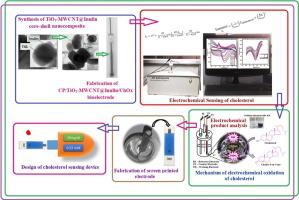当前位置:
X-MOL 学术
›
Enzyme Microb. Technol.
›
论文详情
Our official English website, www.x-mol.net, welcomes your
feedback! (Note: you will need to create a separate account there.)
Cholesterol Oxidase immobilized Inulin based nanocomposite as the sensing material for cholesterol in biological and food samples
Enzyme and Microbial Technology ( IF 3.4 ) Pub Date : 2020-10-01 , DOI: 10.1016/j.enzmictec.2020.109631 Kalaivani G Jayanthi 1 , Suja S K 1
Enzyme and Microbial Technology ( IF 3.4 ) Pub Date : 2020-10-01 , DOI: 10.1016/j.enzmictec.2020.109631 Kalaivani G Jayanthi 1 , Suja S K 1
Affiliation

|
In the present study, inulin based nanocomposite viz., TiO2-MWCNT@Inulin was prepared by embedding Inulin (a biopolymer extracted from Allium sativum L.) with TiO2 and MWCNTs. The morphology of the prepared nanocomposite was characterized by High Resolution transmission electron microscopy (HRTEM). Cholesterol oxidase (ChOx) enzyme was then immobilized into the nanocomposite and the immobilization was examined by UV-vis and FT-IR spectral studies. The ChOx immobilized nanocomposite was integrated into carbon paste (CP) matrix to prepare the working electrode for the sensing of cholesterol. Electrochemical characterization of the modified CP/TiO2-MWCNT@Inulin/ChOx electrode was done by cyclic voltammetric (CV) and electrochemical impedance spectroscopic (EIS) studies. Differential pulse voltammetric (DPV) studies were carried out to determine the concentration of cholesterol at the interface of the newly fabricated electrode. The fabricated electrode demonstrated a linear range from 83 μM to 14.28 mM, low limit of detection (35 μM), good sensitivity (21.26 μA mM-1 cm-2), low Km (0.49 mM), high stability (120 days) and good selectivity. The presence of Inulin biopolymer played a vital role in attaching ChOx enzyme firmly to the nanocomposite thereby enhancing the stability and electron transfer efficiency of the electrode. The analysis of product that was formed within the electrochemical cell during the electrochemical oxidation of cholesterol was performed by using sodium nitroprusside. This resulted in a deep purple coloured solution which suggested the electrochemical conversion of cholesterol to cholestenone. The practical applicability of the fabricated electrode was also assessed by the determination of cholesterol in spiked blood serum and milk samples.
中文翻译:

胆固醇氧化酶固定的菊粉基纳米复合材料作为生物和食品样品中胆固醇的传感材料
在本研究中,基于菊粉的纳米复合材料,即 TiO2-MWCNT@Inulin 是通过将菊粉(一种从大蒜中提取的生物聚合物)与 TiO2 和 MWCNTs 嵌入来制备的。通过高分辨率透射电子显微镜(HRTEM)表征制备的纳米复合材料的形态。然后将胆固醇氧化酶 (ChOx) 酶固定到纳米复合材料中,并通过 UV-vis 和 FT-IR 光谱研究检查固定化。ChOx 固定的纳米复合材料被集成到碳糊 (CP) 基质中,以制备用于检测胆固醇的工作电极。通过循环伏安法 (CV) 和电化学阻抗谱 (EIS) 研究对改性 CP/TiO2-MWCNT@Inulin/ChOx 电极进行电化学表征。进行微分脉冲伏安法 (DPV) 研究以确定新制造的电极界面处的胆固醇浓度。制造的电极表现出从 83 μM 到 14.28 mM 的线性范围、低检测限 (35 μM)、良好的灵敏度 (21.26 μA mM-1 cm-2)、低 Km (0.49 mM)、高稳定性(120 天)和选择性好。菊粉生物聚合物的存在在将 ChOx 酶牢固地附着在纳米复合材料上起到了至关重要的作用,从而提高了电极的稳定性和电子转移效率。使用硝普钠对胆固醇电化学氧化过程中电化学电池内形成的产物进行分析。这产生深紫色溶液,表明胆固醇电化学转化为胆甾酮。还通过测定加标血清和牛奶样品中的胆固醇来评估所制造电极的实际适用性。
更新日期:2020-10-01
中文翻译:

胆固醇氧化酶固定的菊粉基纳米复合材料作为生物和食品样品中胆固醇的传感材料
在本研究中,基于菊粉的纳米复合材料,即 TiO2-MWCNT@Inulin 是通过将菊粉(一种从大蒜中提取的生物聚合物)与 TiO2 和 MWCNTs 嵌入来制备的。通过高分辨率透射电子显微镜(HRTEM)表征制备的纳米复合材料的形态。然后将胆固醇氧化酶 (ChOx) 酶固定到纳米复合材料中,并通过 UV-vis 和 FT-IR 光谱研究检查固定化。ChOx 固定的纳米复合材料被集成到碳糊 (CP) 基质中,以制备用于检测胆固醇的工作电极。通过循环伏安法 (CV) 和电化学阻抗谱 (EIS) 研究对改性 CP/TiO2-MWCNT@Inulin/ChOx 电极进行电化学表征。进行微分脉冲伏安法 (DPV) 研究以确定新制造的电极界面处的胆固醇浓度。制造的电极表现出从 83 μM 到 14.28 mM 的线性范围、低检测限 (35 μM)、良好的灵敏度 (21.26 μA mM-1 cm-2)、低 Km (0.49 mM)、高稳定性(120 天)和选择性好。菊粉生物聚合物的存在在将 ChOx 酶牢固地附着在纳米复合材料上起到了至关重要的作用,从而提高了电极的稳定性和电子转移效率。使用硝普钠对胆固醇电化学氧化过程中电化学电池内形成的产物进行分析。这产生深紫色溶液,表明胆固醇电化学转化为胆甾酮。还通过测定加标血清和牛奶样品中的胆固醇来评估所制造电极的实际适用性。











































 京公网安备 11010802027423号
京公网安备 11010802027423号